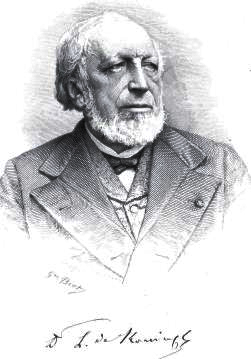Laurent-Guillaume De Koninck on:
[Wikipedia]
[Google]
[Amazon]
 Laurent-Guillaume de Koninck (3 May 1809 – 16 July 1887) was a
Laurent-Guillaume de Koninck (3 May 1809 – 16 July 1887) was a
 Laurent-Guillaume de Koninck (3 May 1809 – 16 July 1887) was a
Laurent-Guillaume de Koninck (3 May 1809 – 16 July 1887) was a Belgian
Belgian may refer to:
* Something of, or related to, Belgium
* Belgians, people from Belgium or of Belgian descent
* Languages of Belgium, languages spoken in Belgium, such as Dutch, French, and German
*Ancient Belgian language, an extinct languag ...
palaeontologist
Paleontology (), also spelled palaeontology or palæontology, is the scientific study of life that existed prior to, and sometimes including, the start of the Holocene epoch (roughly 11,700 years before present). It includes the study of fossi ...
and chemist
A chemist (from Greek ''chēm(ía)'' alchemy; replacing ''chymist'' from Medieval Latin ''alchemist'') is a scientist trained in the study of chemistry. Chemists study the composition of matter and its properties. Chemists carefully describe t ...
, born at Leuven.
He studied medicine in the university of his native town, and in 1831 he became assistant in the chemical schools. He pursued the study of chemistry in Paris, Berlin and Gießen
Giessen, spelled Gießen in German (), is a town in the German state (''Bundesland'') of Hesse, capital of both the district of Giessen and the administrative region of Giessen. The population is approximately 90,000, with roughly 37,000 univers ...
, and was subsequently engaged in teaching the science at Ghent
Ghent ( nl, Gent ; french: Gand ; traditional English: Gaunt) is a city and a municipality in the Flemish Region of Belgium. It is the capital and largest city of the East Flanders province, and the third largest in the country, exceeded i ...
and Liège. In 1856 he was appointed professor of chemistry in the Liège University, and he retained this post until the close of his life.
About the year 1835 he began to devote his leisure to the investigation of the Carboniferous fossils around Liège, and ultimately he became distinguished for his researches on the palaeontology of the Palaeozoic rocks, and especially for his descriptions of the molluscs, brachiopod
Brachiopods (), phylum Brachiopoda, are a phylum of trochozoan animals that have hard "valves" (shells) on the upper and lower surfaces, unlike the left and right arrangement in bivalve molluscs. Brachiopod valves are hinged at the rear end, w ...
s, crustacean
Crustaceans (Crustacea, ) form a large, diverse arthropod taxon which includes such animals as decapods, seed shrimp, branchiopods, fish lice, krill, remipedes, isopods, barnacles, copepods, amphipods and mantis shrimp. The crustacean group can ...
s and crinoid
Crinoids are marine animals that make up the class Crinoidea. Crinoids that are attached to the sea bottom by a stalk in their adult form are commonly called sea lilies, while the unstalked forms are called feather stars or comatulids, which are ...
s of the Carboniferous limestone
Limestone ( calcium carbonate ) is a type of carbonate sedimentary rock which is the main source of the material lime. It is composed mostly of the minerals calcite and aragonite, which are different crystal forms of . Limestone forms whe ...
of Belgium. In recognition of this work the Wollaston medal
The Wollaston Medal is a scientific award for geology, the highest award granted by the Geological Society of London.
The medal is named after William Hyde Wollaston, and was first awarded in 1831. It was originally made of gold (1831–1845), ...
was awarded to him in 1875 by the Geological Society of London
The Geological Society of London, known commonly as the Geological Society, is a learned society based in the United Kingdom. It is the oldest national geological society in the world and the largest in Europe with more than 12,000 Fellows.
Fe ...
, and in 1876 he was appointed professor of palaeontology at Liège. In 1882, he was elected as a member to the American Philosophical Society
The American Philosophical Society (APS), founded in 1743 in Philadelphia, is a scholarly organization that promotes knowledge in the sciences and humanities through research, professional meetings, publications, library resources, and communit ...
.
He was awarded the Clarke Medal
The Clarke Medal is awarded by the Royal Society of New South Wales, the oldest learned society in Australia and the Southern Hemisphere, for distinguished work in the Natural sciences.
The medal is named in honour of the Reverend William Branw ...
by the Royal Society of New South Wales in 1886.
Publications:
*''Eléments de chimie inorganique'' (1839)
*''Description des animaux fossiles qui se trouvent dans le terrain Carbonifère de Belgique'' (1842–1844, supp. 1851)
*''Recherches sur les animaux fossiles'' (1847, 1873)
See ''Notice sur LG de Koninck'', by E Dupont; ''Annuaire de l'Aced. roy. de Belgique'' (1891), with portrait and bibliography.
References
{{DEFAULTSORT:De Koninck, Laurent-Guillaume 1809 births 1887 deaths Belgian paleontologists Scientists from Leuven University of Liège faculty Belgian chemists Wollaston Medal winners